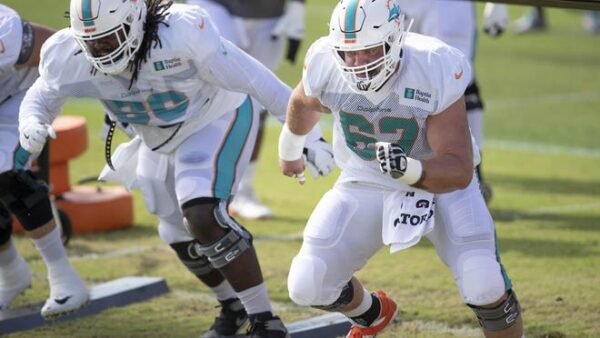
Critical Mass: Protecting Tua Tagovailoa
I think you’d be hard-pressed to find a Dolfan that was giddy about the team drafting Tua Tagovailoa at 5 overall this past April. Especially since Miami didn’t have to trade up to get him. Kudos to Chris Grier and his front office staff of sticking to their guns! But nearly as imperative as getting a franchise signal-caller is being able to protect him. Sounds easy, but as we’ve seen since Joe Philbin became the coach, the Dolphins have struggled at protecting their quarterbacks.
Miami added quite a lot upfront this offseason. Ereck Flowers and Ted Karras arrived as free agents. Austin Jackson, Robert Hunt, and Solomon Kindley by way of the Draft. They join incumbents Julien Davenport, Michael Deiter, Shaq Calhoun, and Jesse Davis from the line that finished Week 17 against the Patriots last year. So how does it all come together?
When you step back and look at the picture from 30,000 feet, you’ll notice a philosophical sea change. Miami’s additions are BIG. Back to that in a second. Strictly in terms of body type and playing style, what NFL quarterback would compare to Tua Tagovailoa? Well, you’re looking for someone who is: shorter at 6’0”; possesses good quickness and agility in the pocket but isn’t a gifted open-field runner; successful in a rhythm/timing-based passing offense; deadly accurate in short and medium-range areas; has an above-average to good NFL arm, but isn’t sniffing the neighborhood of a Mahomes or Rodgers? Drew Brees is who I arrive at. Tua looks and plays like a left-handed Drew Brees.
***Disclaimer. By no means am I saying Tua will be as good as Drew Brees. Just that in terms of body type and playing style, they’re pretty similar. I’s say Tua’s career arc probably runs somewhere between a left-handed Andy Dalton and a left-handed Drew Brees. There’s a lot of room between those two.***
Back to the size of the O-line. Saints Coach Sean Payton’s had to protect Drew Brees for over a decade now. The Saints have usually had pretty athletic offensive tackles. Most teams strive for that. Miami’s no different. But look at the interior players the Saints have had. Their guards and centers. Sean Payton once gave an interview saying that they like their guards to have “ass and mass”. He gave another great line when they signed Larry Warford in free agency, saying, “He’s got ass and mass. We’ve got a saying, ass, and mass, kick ass.” And the Saints have had a stable of big guards and centers over the years:
LG Carl Nicks – 6’5” 343lbs
RG Jahri Evans – 6’4” 320lbs
C Jonathan Goodwin – 6’3” 318lbs
LG Andrus Peat – 6’6” 325lbs
RG Larry Warford – 6’3” 317lbs
C Erik McCoy – 6’4” 314lbs
C Cesar Ruiz – 6’4” 316lbs
I believe Miami’s onto a similar path with regard to protecting Tua. So far as we know through camp, the starting LG-C-RG trio have been Ereck Flowers (6’6” 343lbs), Ted Karras (6’4” 314lbs), and Solomon Kindley (6’3” 335lbs). That’s nearly 1,000lbs of beef combined. That got me to thinking about just how well that trio will pass-protect when Tua Tagovailoa finally takes the reins. So, with that in mind, I did a study on each of these three just to see how they pass-blocked. If you’re looking for run-blocking prowess or grades, this article isn’t for you. This is simply to see if these three dancing bears will help keep Tua upright in the pocket.
To give them some kind of comparable score, I watched three games of each player’s pass-protection sets only. This also includes some snaps where there were penalties that allowed the play to be finished (i.e. holding, pass interference).
I broke down pass-protection plays into three categories:
Plus – the player has a successful 1-on-1 block or successfully helps pass off a player in the pass-rush game and doesn’t allow the quarterback to be pressured – to be moved off his spot in the pocket.
No Impact – if the player has no 1-on-1 pass-blocking assignment and his efforts to find work and double another defender don’t impact the play in any way. Or, the player carried out a play-action (i.e. pulled across the formation to indicate a lead block on a run) and the quarterback rolled the other way or there was no defender to occupy. In short, the player had no impact either way.
Negative – the player’s 1-on-1 assignment pressured, hit, or sacked the QB or the player poorly switched off a defender in a pass-rush game leading to a pressure, hit or sack by his assignment or the player he switched off.
I tallied the plus, no impact, and minus plays for each player, so you’ll see total snaps. To calculate the grade, I threw out all the no impact snaps and took the percentage of plus plays from the total remaining snaps (positive and negative). Here are the results:
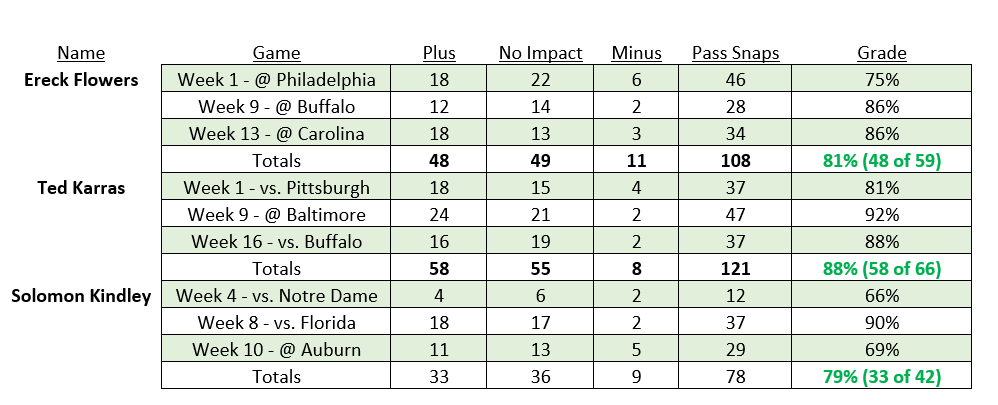
As you can see, all three of Flowers, Karras, and Kindley graded out near or above 80% in terms of plus plays on passing attempts. Think about that for a second. Essentially, four out of every five pass plays, the man they’re responsible for does not disrupt the quarterback in any fashion! Two of these guys did that against NFL players, which honestly, makes their grades all the more impressive, especially Ted Karras’s grade.
To dive in further, I wanted to try and get a sense for how each player progressed throughout the season. Ereck Flowers was playing guard for the first time ever. Ted Karras had only logged snaps at guard for the Patriots before stepping in for David Andrews at center last year. Only Kindley played the same position in 2019 as he had done the previous year. Let’s take a look at each player.
— DolphinsTalk.com (@DolphinsTalk) August 25, 2020
Ereck Flowers
I wanted to check out his game against Philadelphia because it was the first time he played guard in a regular-season game, and the Eagles had some really nice interior players: Fletcher Cox, Malik Jackson, Timmy Jernigan and even rotated Brandon Graham inside a few snaps. In this game, Washington used a lot of play-action concepts where they rolled Case Keenum opposite the play action. The first pass play of the game, they fake a sweep to the right and roll Keenum naked left. On this play, Flowers has no impact as he doesn’t have to block anyone. As both teams got settled in, Flowers started to show why he can pass-protect inside.
He’s big. He’s long. He’s heavy and tough to move. He held his own against Fletcher Cox in the few times they went against each other. Cox mostly rushed against Brandon Scherff. Malik Jackson gave Flowers some issues, beating him once with a great chop-rip move. He beat Flowers once and tallied a pressure. Jackson beat him again later in the game and Flowers drew a holding penalty. But, other than those two plays, Flowers graded out well with 18 plus plays in 24 snaps where his play directly impacted the QB.
One of the things you notice first is his grip strength. If he gets his hand punch right and gets his hands inside of the defender’s shoulders, the rep is over. He’s won. Getting that technique down more consistently will be something to watch this year. Rashad Butler, the former Miami Hurricane, Cleveland Brown and Houston Texan talked about this on Twitter when Flowers first signed with the Dolphins. Rashad’s a tremendous follow! You can find him on Twitter at @RashadJamaalB. Back to Flowers, he also did a great job handling twist games. In this example, he and Donald Penn effectively pass off an End-Tackle Twist, and Flowers engulfs Derek Barnett with ease allowing Keenum to get the pass off without any pressure.
Flowers pic.twitter.com/ZzUkAQyZkB
— Kevin Dern (@KevinMD4) August 25, 2020
I also wanted to see Flowers against an AFC East opponent, so I watched his week nine game against the Buffalo Bills. The Bills also boasted an impressive group last year at DT with Ed Oliver, Star Lotulelei, and former Dolphins Jordan Phillips and Vincent Taylor. Of the three games I graded of Flowers, this one was his best. He didn’t give up any sacks and allowed just one pressure. He showcased his size well, knocking Jordan Phillips down while assisting in a double team block. And for someone who is 6’6” 343lbs, Flowers can move pretty well. You can see why he was an OT in the early part of his career. Washington tried several screens and Flowers can move in space pretty well. My other minus on him was for not being able to sustain a block on a screen, but the play probably wouldn’t have gone for a first down regardless. Flowers graded out with 12 of 14 plus plays in the 14 snaps that directly impacted the QB.
Finally, I was given the recommendation to watch Flowers against Carolina. He was outstanding, other than once sack allowed to Gerald McCoy. This game was in Week 13 near the end of the year, so I figured Flowers would look more polished than he did earlier in the season. He looked much more comfortable and is quicker than you’d expect when getting into his set or moving out in space on screens. He also showed a better ability to keep using his hands to get inside of a defender. You can see it here in this rep against Stacy McGee where his hands initially get outside, but he keeps working to reset and drop his anchor and is able to ride McGee away from Dwayne Haskins.
More Flowers pic.twitter.com/MEoM697sTf
— Kevin Dern (@KevinMD4) August 25, 2020
Overall, Flowers graded out hitting 48 of 59 plus plays indirectly impactful snaps, for a grade of 81%. In other words, when his opponent has a chance of directly impacting the quarterback’s pass set, Flowers wins the matchup 81% of the time. We’ve seen from several of the beat writers this year that Flowers has been taking other linemen under his wing before and after practice. You love to see that, and I think we as Dolfans will love to see his pass protection abilities in 2020.
Ted Karras
Steady Teddy. That’s what I ended up calling Karras after watching three games of his. I took a look at Week 1 against the Steelers and their front three consisting of Stephone Tuitt, Cameron Heyward, and Javon Hargrave. Karras hit 18 plus grades in 22 chances in this game. One of the things about New England’s offense was that they focused on getting the ball out quickly and Karras ended up having a lot of reps in all three games where the ball gets out so quickly whatever he did ended up not mattering. Against the, it’s apparent that he’s stout, and he’s hard to move off his spot when he anchors. He can get out in space sneaky well on screens when there’s no trash to sift through. He occasionally lollipopped a shotgun snap against the Steelers (slow, fat snap; not crisp) but aside from that, it was a good night for Ted.
I was really impressed with Karras in his game against Baltimore. Steady Teddy showed up this night as the rest of the O-line sort of burned around him. This Week 9 matchup saw Karras’s shotgun snaps looking much crisper in this game. He also proved sound at handling twists, much like Flowers, so that was good to see. He gave up one pressure to Michael Pearce, but Karras got his wins in too.
Here we see Karras get his hands up quickly off the snap right into Pearce’s chest plate. Karras is able to reset and keep his hands on Pearce before driving him to the ground.
Karras 1 pic.twitter.com/KP2W9gG6mI
— Kevin Dern (@KevinMD4) August 25, 2020
Later in the game, New England tries a flea-flicker. Karras once again draws Pearce 1-on-1 and holds this block for a while with ease. Just watch him work.
Karras 2 pic.twitter.com/70WnmOZ4G9
— Kevin Dern (@KevinMD4) August 25, 2020
While New England took a bad loss to the Ravens, Karras’s pass-blocking was pretty good, notching 24 plus grades on 26 directly impactful snaps, for a grade of 92%, which was the best of the nine total games I watched of the three players! Again, it must be said New England did a lot to try and get the ball out quick and there were 21 pass snaps where Karras got a No Impact grade in this game.
Finally, I watched the Bills at New England in Week 16 to see a common opponent between Flowers and Karras last year. It was more of the same for Steady Teddy as he notched plus grades on 16 of 18 direct impact plays, an 88% grade. New England again had 19 plays where I scored him No Impact. The things of note in this game that stood out to me were that he handled Ed Oliver pretty easily. There’s also a great rep on a screen pass where Karras is able to get into the open field, track and bump Tremaine Edmunds away from the play, which wasn’t easy to do.
Overall, with Karras, he showed that he’s likely not going to be easy to beat 1-on-1, especially by bigger DTs. He’s able to keep working his hands and drop anchor in time for the QB to get the pass off. He’ll have to maintain the consistency he showed with his shotgun snaps later in the year. That’s something to watch. But all in all, he moved much better than I thought a big center would, and he’s got active very active hands.
Solomon Kindley
First off, kudos to the Between the Hedges Channel on YouTube. I wasn’t able to get my hands on any All-22 tape of Georgia from 2019, but this channel has all of Jake Fromm’s passing snaps on it, so that made watching Kindley very helpful. I picked three games that I thought would provide different challenges for Kindley. Selfishly, Khalid Kareem was one of my favorite prospects to watch, so I made sure to include Georgia’s game against Notre Dame. I also put Florida and Auburn on the menu. The Auburn game was due to Miami having such an interest in former Tiger players having drafted Noah Igbinoghene and at various points, signing Javaris Davis and Jeremiah Dinson. They were also linked to Marlon Davidson and Michael Coe in the run-up to the Draft.
Back to Kindley. The first thing I noticed is that he was BIG. Probably too big while at Georgia, where he was listed at 335lbs. I think he’s converted some of that bad weight into good weight and he says he’s now 335lbs with the Dolphins while looking noticeably slimmer.
In the Notre Dame game, I believe Kindley got injured at some point because he didn’t finish out the game. Georgia did a lot to get the ball out of Jake Fromm’s hands quickly in this game, so there were several No Impact reps for Kindley. But there’s still reps to watch. One benefit of Kindley’s size is that it buys him time to gather himself, reset and drop anchor when his technique isn’t quite right. In this play, you’ll see Kindley and Georgia’s center pass off a twist from the LB an DT. Kindley gets rocked back when the DT makes contact, but he’s able to gather himself and basically stop both himself and the Notre Dame defender in their tracks giving Fromm time to throw. If this timestamp doesn’t work, go to the 1:07 mark.
In the Notre Dame game, I had Kindley with four-plus reps out of six attempts, so a grade of 66%, albeit in a smaller sample size.
Against Florida, we see another rep where Kindley’s size comes into play. He times his hand punch a beat slow and lets the Gator DT get his hands under his pads. However, Kindley’s able to recover and maintain contact long enough to allow Jake Fromm to find room to escape the pocket and scramble. Go to 1:27 mark if the timestamp doesn’t work.
I was reminded of this by Chris Kouffman on Twitter last week, but for a big man, Kindley’s got shorter arms, at 32.25” inches. That factored into the play above and will be something to look out for. Chris pointed out in one of the Dolphins video Tweets that Christian Wilkins blew past Kindley in the pit drill for a would-be sack. He’ll have to compensate with better footwork.
On this rep against the Gators, we’ll see Kindley with a better hand reset and his ability to drop anchor. Much like Ereck Flowers, if Kindley’s able to get both hands inside, he’s so strong that the rep is over. Go to the 3:05 mark if the timestamp doesn’t work.
One more clip of Kindley against the Gators. So, we’ve read several reports of him moving pretty well. This clip is a good rep of him showing athleticism and getting into space to block on the screen. If the Gator defender doesn’t trip, it’s going to be a BIG collision. Still, Kindley’s effort here gets the job done and the Bulldogs get positive yards. Overall, Kindley had his best game of the three I looked at against Florida, notching 18 of 20 plus snaps in impactful reps, or 90%.
Finally, I wanted to take a look at Kindley against Auburn. Georgia was the only team to come into Jordan-Hare Stadium and leave with a victory. So that was intriguing along with the connections Auburn players have and had to the Dolphins. Some extra clips here too!
The first one is a bullfight. Two grown men here. Auburn’s Derrick Brown was about the only person to walk Solomon Kindley back. But, as you can see in the clip, Derrick Brown doesn’t do it easily. So, that bodes well for Miami quarterbacks; if Kindley can keep his hands inside, he’s damn near impossible to walk back into the quarterback’s lap. Go to the 3:18 mark if the timestamp doesn’t work.
In this rep, Kindley goes against Nick Coe. We see what Kindley looks like when he gets everything right on a rep. Go to the 4:34 mark if the timestamp doesn’t work.
Later on the same drive, we get a look at another of Kindley’s perfect reps. This time it’s from slightly behind the play, so you get an almost All-22 look on the replay. Go to 4:55 if the timestamp doesn’t work.
Against Auburn, Kindley got plus grades on 11 of 16 impactful reps from me, for 69%. The Florida game boosted his total to a 79% overall grade. But what stands out to me from the three games is that when Kindley, and really all three guys, get their hand punch timed right and get hands INSIDE, they win.
Moving forward, when Tua Tagovailoa does get the keys to the Dolphins offense, I think he can feel pretty comfortable with an interior trio of Ereck Flowers, Ted Karras, and Solomon Kindley protecting him. All three guys are big. They move well for their size. They’re stout and able to reset and drop anchor quickly. For their respective sizes, they all do a pretty good job of getting out in space and locating someone at the second or third level to block. I think that could be an underrated aspect of each these guy’s games, especially if Chan Gailey’s dialing up as many screen passes as he did when he was with the Jets and Ryan Fitzpatrick.
Ultimately, I think this trio, along with the combination of RPOs and various other play calls, will help to keep Tua Tagovailoa clean from pressure up the middle of the pocket. When there is trouble brewing, all three guys are big enough and able to reset their hands quickly enough to help mitigate pressure long enough for someone of Tua’s caliber to maneuver within the pocket. I think people forget how quick-twitch Tua was when he was on the field, and can buy some time when needed, much like Drew Brees does in the pocket. All in all, I think Tua will be pretty glad to have this beastly trio protecting the middle of the pocket. And we as Dolfans will be glad Tua! Get it? That’s all from me for this one. Catch you next time!


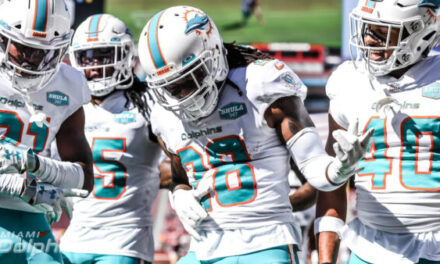
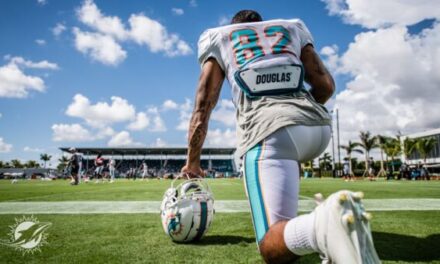
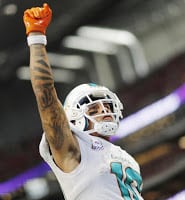






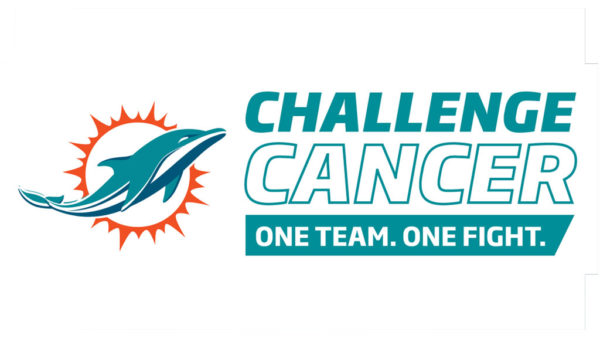



Thanks for the detailed analysis, Kevin.
Another way to look at this is that we can expect, on average, 9 pressures per game from the interior OL. That seems a little high to me, but i’m not sure, what do you think?